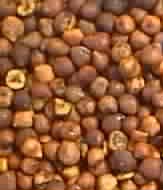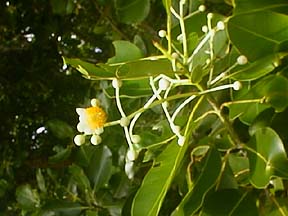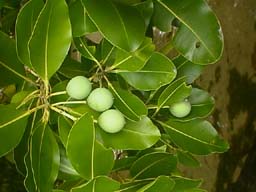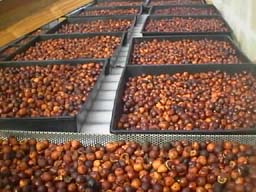 |
 |
||||||
|
|
About the Oils The hefau tree (Calophyllum inophyllum) is indigenous to Southeast Asia and is widespread throughout Polynesia. It grows up to 20 meters in height, with long, spreading limbs. It produces round fruits with a bittersweet kernel that is rich in a resinous oil.
The name Calophyllum means "beautiful leaf," from the Greek words Kalos = beautiful, and phullon = leaf. The average hefau tree produces about 200 pounds of nuts per year from which can be extracted only about 10 pounds of oil. The kernels are dried in the sun for approximately two months after being extracted from their shells. When the kernels are thoroughly dried they are cold-pressed to extract the oil. Before processing, the oil contains resins that must be eliminated through a careful purification process. The limited production of oil per tree and the high cost of extraction and purification explain why the oil is relatively expensive and in limited supply.
The oil possesses antibacterial and anti-inflamatory characteristics. When applied to wounds or burns it not only heals rapidly, it has amazing cicatrization qualities. It is for topical use only, and should not be taken internally. People with allergies to nuts of any kind should avoid use of the oil. Active ingredients: Hefau oil is comprised of lipids (glycolipids, neutral lipids, and phospholipids), a fatty acid (calophyllic), an antibiotic lactone, and an anti-inflammatory agent (calophyllolide).
Applications: In a recent assessment of the healing properties of the oil, researchers found convincing evidence that "it heals small wounds, such as cracks and chaps, but is also efficient on more serious cutaneous problems: atonic wounds, physical and chemical burns, radiodermatitis, anal fissures or post-surgical wounds. . . . The oil is especially recommended for all kinds of burns (sunburns or chemical burns), most dermatoses, post-surgical cicatrisation, certain skin allergies, acne, psoriasis, herpes, chillblains, skin cracks, diabetic sores, hemorroids, dry skin, insomnia, hair loss, etc.” (A.C. Dweck, et al., "Tamanu - Calophyllum inophyllum: the African, Asian, Polynesian and Pacific Panacea." The International Journal of Cosmetic Science, 2002, No. 24, pp 1-8. )
|


